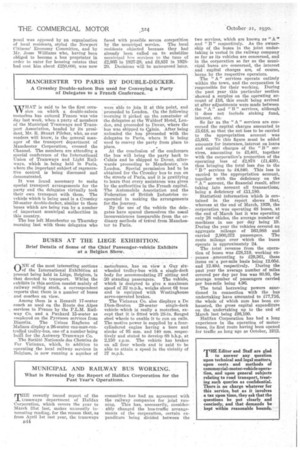MUNICIPAL AND RAILWAY BUS WORKING.
Page 70

If you've noticed an error in this article please click here to report it so we can fix it.
What is Revealed by the Report of Halifax Corporation for the Past Year's Operations.
THE recently issued report of the tramways department of Halifax Corporation, which covers the year to March 31st lust, makes unusually interesting, reading, for the reason that, as from April let last year, the tramways
n44 committee has had an agreement with the railway companies for joint running. This has, necessarily, considerably changed the bus-traffic arrangements of the corporation, certain expenditure being divided between the two services, which are known as " A " and " B " respectively. As the ownership of the buses in the joint undertaking is vested in the railway company so far as its vehicles are concerned, and in the corporation so far as the mini' cipal buses are concerned, the interest • and-. capital charges are, of course, • borne by the respective operators.
The " A " services operate entirely within the town, and the corporation is 'responsible for their working. During the past year this particular section showed a surplus on the operating account of 116, this result being arrived at after adjustments were made between the "A" and "B " services, although it does not include sinking fund, interest, ete.
So far as the " A " services are concerned the capital charges amounted to 15,618, 60 that the net•loss to be carried to the appropriation account was 15,602. To this figure must be added amounts for insurance, interest on loans and capital charges of the " B " services, amounting to /3,401, together with the corporation's proportion of the operating loss of 12,878 (11,439), thus bringing the total loss due to the "B." services to £4,840. This loss is carried to the appropriation account, together with the deficiency on the " A" account, the financial result, after taking into account all transactions, being a deficiency of /11,180.
• Statistical information which is contained in the report shows that, whereas at the• end• of March, 1929, the corporation was operating 48 buses, at the end of March last it was operating only 28 vehicles, the average number of machines in use per day being 19. During the year the vehicles covered an aggregate mileage of 563,988 and carried 2,800,372 passengers. The route mileage over which the buses operate is approximately 24.
The total revenue from the operation of buses was 128,319, working expenses .mounting to 129,361, these items on a per-mile basis being 12,o5d. and _12.49d. respectively. During the past year the average number of miles covered per day per bus was 80.93, the average number of passengers carried per bus-mile being 4.96.
The total borrowing powers sanctioned in connection with the bus undertaking have amounted to 177,716, the whole of which sum has -been exhausted, the gross capital expenditure on the undertaking up to the end of March last being 198,100.
Halifax Corporation has had a long experience in the operation of motorbuses, its first route having been opened for traffic as long ago as October, 1912.




















































































































